Salvia sclarea
Salvia sclarea {{{latin_name}}}
|
'
| ||||||||||||||||||||||||||||||||||||||||
|---|---|---|---|---|---|---|---|---|---|---|---|---|---|---|---|---|---|---|---|---|---|---|---|---|---|---|---|---|---|---|---|---|---|---|---|---|---|---|---|---|---|

|
|
| |||||||||||||||||||||||||||||||||||||||
| |||||||||||||||||||||||||||||||||||||||||
| Standard Cyclopedia of Horticulture |
|---|
|
Salvia sclarea. (S. bracteata, Sims, not Soland., in Russ. S. Simsiana, R. & S.). Clary. Biennial, 2-3 ft. high: st. herbaceous, stout, erect, villous: lvs. often 8-9 x 4-5 in., petiolate, broad-ovate, erose-crenate, base cordate, hoary, the uppermost clasping; floral lvs. very broad, acuminate, concave, membranaceous, colored, their base white, their tips rose: racemes paniculate; floral whorls distant, about 6-fld.; calyx campanulate, striate, pubescent-hispid, the teeth rather spiny-acuminate; corolla whitish blue, the tube included. Aug. S. Eu. Var. turkestanica, Hort. (S. turkestanica, Hort. S. turkestaniana, Hort.), grows 3 ft. high, has quadrangular sts. tinged with pink, basal lvs. on long petioles and long spikes, 2 1/2 ft. high, of large white fls., tinged with pink. There is a form offered in the trade under the name of S. turkestanica superba, Hort., which has "dense branched pyramids of silky foliage and conspicuous rosy bracts, and white fls." S. bracteata, Soland., in Russ., is a valid species belonging to Section 1. It is a subshrub about 1-1 1/2 ft. high, with purplish fls. and a native of Asia Minor and Syria. Probably not in cult.
|
Cultivation
- Do you have cultivation info on this plant? Edit this section!
Propagation
- Do you have propagation info on this plant? Edit this section!
Pests and diseases
- Do you have pest and disease info on this plant? Edit this section!
Species
Gallery
If you have a photo of this plant, please upload it! Plus, there may be other photos available for you to add.
-
photo 1
-
photo 2
-
photo 3
References
- Standard Cyclopedia of Horticulture, by L. H. Bailey, MacMillan Co., 1963
External links
- w:Salvia sclarea. Some of the material on this page may be from Wikipedia, under the Creative Commons license.
- Salvia sclarea QR Code (Size 50, 100, 200, 500)
